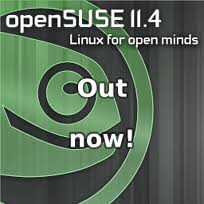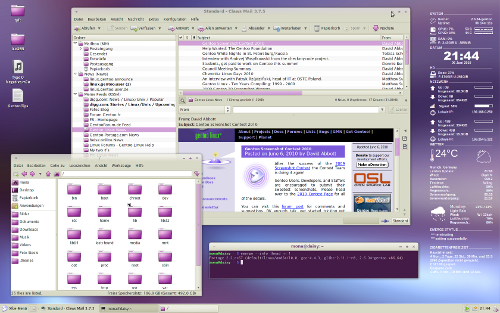 Cosa hanno in comune queste due distribuzioni ?
Cosa hanno in comune queste due distribuzioni ?
Molto poco secondo me, tranne il fatto che la ultima release di entrambe è uscita la scorsa settimana, siamo arrivati alla versione 11 del Gentoo live dvd, in gentoo si fa riferimento usualmente alla versione del DVD in quanto è una “rolling release” al contrario di Opensuse che come altre distribuzioni rilascia versioni periodicamente ed è arrivata ora alla versione Opensuse 11.4.
Quindi, vediamo che cosa queste due distribuzioni sono in grado di offrire agli utenti Linux.
Caratteristiche Generali
Opensuse
Il progetto openSUSE è un progetto supportotato da una comunità globale sponsorizzata da Novell, con l’obiettivo di offrire il più facile da utilizzare e da usare sistema Linux per il desktop. openSUSE (in precedenza noto come Suse o SuSE), è una distribuzione Linux attiva da un bel po’ (prima apparizione nel 1992 come SuSE). In passato era una soluzione business-only, si concentra ora sui desktop degli utenti home e workstations.
Gentoo
Distro per utenti avanzati, consapevoli e pazienti e anche per coloro a cui piace vedere i mennasmi interni. Gentoo è una distribuzione che non si basa su pacchetti binari (anche se ce ne sono alcuni disponibili), ma si concentra piuttosto sulla costruzione del sistema operativo ottimizzato per l’hardware di destinazione. Installazione e configurazione di Gentoo può richiedere giorni. Gli utenti dicono che vale la pena a causa del controllo e il miglioramento della velocità.
Sistema di base
Gentoo
Come ho scritto, Gentoo è una distribuzione con “rolling release” quindi questi pacchetti (e tutti i seguenti) si riferiscono a ciò che si può trovare nel DVD Live, una volta installato sarete in grado di aggiornare ogni pacchetto installato e con una release successiva presente sul repository.
Pacchetti di sistema includono: binutils Linux Kernel 2.6.37 (con le patch di Gentoo), Supporto per l’accesso con Speakup 3.1.6, bash 4.1, glibc 2.12.2, GCC 4.5.2, 2.21, Python 2.7.1 e 3.1.3 e Perl 5.12.3.
OpenSuse
La 11.4 è basata sul Kernel 2.6.37, che migliora la scalabilità di gestione della memoria virtuale e la separazione dei compiti eseguiti dagli utenti del terminale, il che migliora la scalabilità e le prestazioni ed ha minori interferenze tra le attività. Il nuovo kernel porta anche un migliore supporto hardware, con i driver open Broadcom Wireless, è migliorato il supporto Wacom e molti altri driver nuovi o aggiornati. Supporta inoltre i miglioramenti ai driver grafici negli ultimi Xorg e Mesa, così gli utenti potranno godere di una migliore accelerazione 2D e 3D.
Desktops and Applications
OpenSuse offre sia Gnome che KDE, ma tenete presente che questa distribuzione ha una lunga tradizione per essere una distribuzione KDE, quindi io suggeriscono fortemente di utilizzarla con questo Desktop Manager per ottenere il massimo.
Il KDE Plasma Desktop 4.6 introduce capacità di script al manager di finestre KWin ed una più facile gestione delle attività così come miglioramenti alla gestione della rete e il bluetooth. GNOME 2.32 migliora l’usabilità e l’accessibilità. 11.4 ha anche GNOME Shell, nell’ambito dell’imminente GNOME3, disponibili per i test. Xfce 4,8 rende ora possibile utilizzare l’esecuzione di GIO VFS per una migliore navigazione del file system remoto e udev, ConsoleKit e PolicyKit. Il più leggero LXDE 0,5 non ha visto grandi cambiamenti in questa release, ma continua a rafforzare la stabilità e l’usabilità con una serie di bugfix, associazione di file e una migliore tematizzazione.
Firefox 4.0, è stato inserito in 11.4, introduce una riprogettazione dell’interfaccia utente con le schede spostate nella parte superiore della barra degli strumenti, il supporto per appuntare delle schede e altro ancora. 11,4 comprende altro software libero tra i più popolari ad oggi in quanto è la prima distribuzione a distribuire LibreOffice 3.3.1. Nella 11.4 debutta anche il risultato di quasi 4 anni di lavoro con la versione 1.4 Scribus basata su Qt 4 e la tecnologia Cairo.
Gentoo non ha un Desktop Manager preferito, si è liberi di costruire da zero un ambiente con KDE, Gnome o Fluxbox.
Questi sono alcuni dei pacchetti compresi nel DVD (e quindi disponibile anche nell’installazione):
- Gli ambienti desktop e window manager includono: KDE SC 4.6, GNOME 2.32, Xfce 4.8, Enlightenment 1.0.7, Openbox 3.4.11.2, Fluxbox 1.3.1, XBMC 10.0.
- Ufficio, grafica e le applicazioni di produttività includono: OpenOffice 3.2.1, XEmacs 21.5.29 gVim 7.3.102, Abiword 2.8.6, GnuCash 2.2.9, Scribus 1.9.3, GIMP 2.6.11, Inkscape 0.48.1, Blender 2.49b, XSane 0.997.
- Web browsers includono: Mozilla Firefox 3.6.13, Arora 0.11.0, Opera 11.0, Epiphany 2.30.6, Seamonkey 2.0.11.
- Gli strumenti di comunicazione includono: Pidgin 2.7.10, Quassel 0.7.1, Mozilla Thunderbird 3.1.7, Claws Mail 3.7.8, Qtwitter 0.10.0, irssi 0.8.15.
Video Recensioni
Purtroppo Gentoo 11 non è ancora disponibile come recensione, ma quella trovata è abbastanza recente per farvi un’idea:
Popolarità su Distro watch
Questi sono i numeri per gli ultimi 7 giorni:
Opensuse: 2532
Gentoo: 1134
Si consideri inoltre che openSUSE è stata rilasciata 2 giorni dopo Gentoo, quindi è chiaro quale delle due è più utilizzata.
Conclusioni
Sul fronte applicazioni devo dire che Opensuse ha osato molto di più, introducendo Firefox 4.0 (ad oggi ancora in Beta) e Libreoffice al posto di OpenOffice. Ma se siete fan di gentoo non vi preoccupate troppo, proprio per la sua natura è possibile passare da Firefox 3.6 a 4.0 anche fra due o tre mesi all’interno senza dover aggiornare il tutto.
Come mi aspettavo OpenSuse è molto più popolare di Gentoo per numero di persone che la utilizzano.
Quindi, quale delle due ?
Come al solito non c’e’ una unica risposta buona secondo me, visto anche il differente approccio tra le due versioni.
Se volete una distribuzione pronta e funzionante con poco, che abbia un ottimo ambiente KDE pronto la risposta è Opensuse.
Se non è la vostra prima installazione Linux, ed avete voglia di leggere manuali ed imparare qualcosa in più, perdendo si del tempo ma capendo molto di più di Linux allora vi consiglio di provare Gentoo.
Personalmente io mi trovo bene con le mie 3 distribuzioni: Xubuntu 10.10 a casa, Gentoo Fluxbox/Gnome al lavoro e Debian Squeeze per la mia ragazza, buona installazione.
Popular Posts:
- None Found



Why not split it down the middle and install Arch?
Using the Gentoo LiveCD as the comparator in assessing Gentoo against another distro is very silly.
The Gentoo LiveCD does not and is not intended to provide users with a proper Gentoo experience and it should not be used as a substitute for one.
There is only one way to experience Gentoo, install it.
Also openSUSE now offers a rolling release option which you omitted to mention.
Thanks for the info i did not noticed this change in Opensuse.